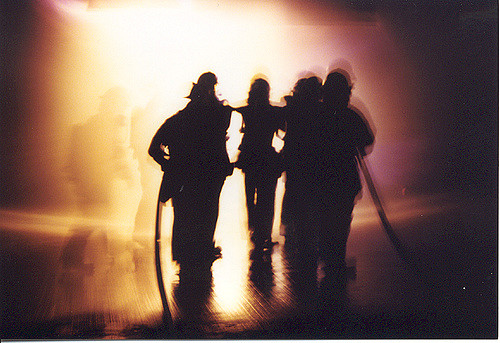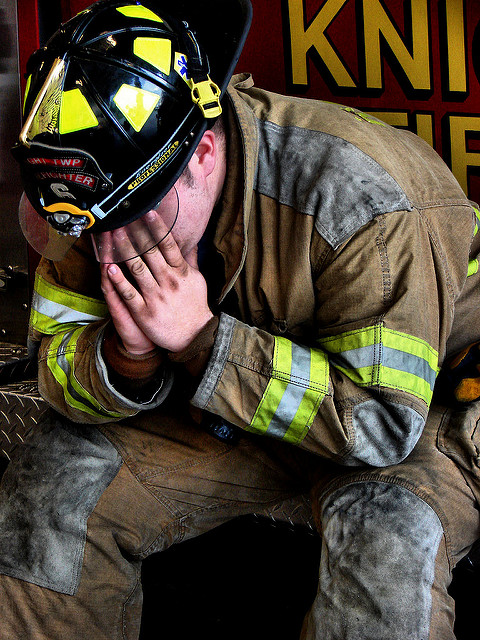
Firefighters Fight Stress as First Responders
We tend to think of firefighters saving lives as fires tear through homes or forest land. What many people don’t know is that firefighters are also first responders, arriving at crisis scenes even before paramedics or police officers.
Working in stressful and traumatic situations can take a toll on their mental health. Post Traumatic Stress Disorder (PTSD) and suicide rates are much higher in first responders than in most other professions. Canadian first responders experience twice the rate of PTSD compared to civilians.
Ongoing exposure to stress means that access to support is critical. But cultural and administrative barriers get in the way. Because firefighters are regarded as tough and invulnerable, many feel embarrassed to ask for help, and available programs can be difficult to navigate.
Brian (name changed for anonymity), a 30-year veteran of the fire service and a District Chief in Ontario, Canada has experienced the stressful effects of the job firsthand, and has witnessed the toll it takes on colleagues and family:
“You’re just supposed to deal with the effects of the job. The stigma is that, if you can’t handle it, you’re weak. This idea has been built into the profession.”

When Brian entered his new role as District Chief, he received very little training on how to support the well-being of those working under him. He received only a phone number to an Employee Assistance Program (EAP) to distribute to team members if they had an exceptionally stressful day. The call is left up to individual firefighters rather than to an outreach program that communicates to them directly.
Although Brian believes that firefighters can benefit from the EAP, he knows that stigma exists around making the call. So, the resource doesn’t get used.
“There have always been employee assistance programs. In all my thirty years, I’ve only seen the EAP used once or twice. For the program to work, the agency needs to call the firefighters, because firefighters don’t reach out.”
To fight this stigma, the province of Ontario has launched several initiatives, including a new radio and digital campaign created to raise awareness and reduce the hesitancy of first responders to seek support. A free online toolkit has also been developed that addresses how to cope with PTSD.
Social support is another essential component of first responders’ wellbeing. In a study published in the Journal of Occupational Health Psychology, Jasmine Huynh of Flinders University and colleagues found that support from family and friends was critical for protecting workers from burnout and for them to cope with the demands of frontline responsibilities.
Brian and his wife Sandra (name changed for anonymity) find support in each other and also through other firefighters and their families. Sandra explains that they often use humour to address the stress:
“When you go into the fire hall, there’s a lot of humour. I think we use humour t
o deal with the pressure, to keep going. That’s our coping mechanism. It’s also how we manage the stress as a family.”
While some programs exist to help firefighters work through their own issues, there is very little support for families of first responders. Having a loved one who is a firefighter can take a toll on the whole household.
In a study by social work professor Cheryl Regehr and a group of researchers at the University of Toronto, the authors explored how firefighters’ wives coped with the mental distress caused by their husbands’ emotionally taxing jobs. Wives handled partner stress by emotionally distancing themselves when necessary.
After thirty years, Sandra has learned to better read Brian’s emotional states, allowing her to recognize when he needs some space after a bad shift. She explains:
“If he comes home and is quiet, and not himself, I know that something is wrong. But I just let it go and let time pass, and then, eventually, I ask him about it. I can tell when it has been a rough shift. If he wants to be alone, I let him be.”

In an attempt to shield his children from the dangers of his job, Brian doesn’t discuss work much at home:
“When I was initially on the job, I talked to Sandra a lot about it, but when the kids came, I stopped. You don’t want to bring the experiences home; you don’t want the kids to worry. It’s bad enough that Sandra worries.”
Despite being proud of her husband, Sandra can’t help but feel constant fear in the back of her mind:
“I think about Brian’s safety all the time. The fear is always there. When he was first on the job, I tried not to think about it. I didn’t watch the news, and if I did, I prayed it wasn’t his fire truck at an emergency.”
To her relief, it has always been someone else’s fire truck. But that someone usually has a family at home, also worrying.
Brian and Sandra agree that more needs to be done to support frontline workers and families. At least initiatives like the media campaign and online toolkit serve as a starting point for an open dialogue surrounding the stigma of seeking help.
At the end of the day, Brian’s job is just that: a job. He says:
“People want to call us heroes. Most of the time, I don’t classify us as heroes. We do what we’re trained to do, and if we do it well, we all come home.”
– Alyssa Carvajal, Contributing Writer
Image Credits
Feature: Truthout.org at flickr, Creative Commons
First: Kara B at flickr, Creative Commons
Second: jksphotos at flickr, Creative Commons



